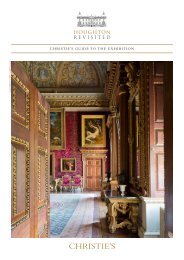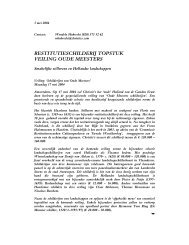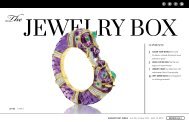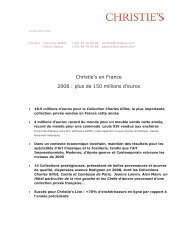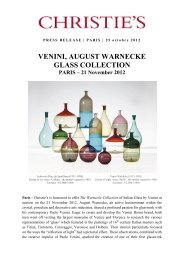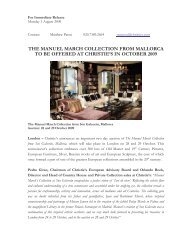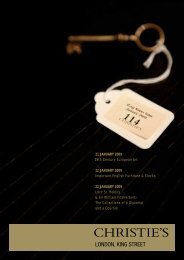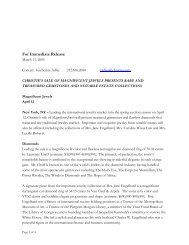Yves Saint Laurent Pierre Bergé - Christie's
Yves Saint Laurent Pierre Bergé - Christie's
Yves Saint Laurent Pierre Bergé - Christie's
Create successful ePaper yourself
Turn your PDF publications into a flip-book with our unique Google optimized e-Paper software.
60<br />
Armand-Albert Rateau<br />
A modern link with the antique<br />
Armand-Albert Rateau, born in Paris in 1882,<br />
found his precocious direction in the world of art<br />
when he joined the École Boulle in 1894. After two<br />
years of study, he trained as an apprentice to<br />
famous decorators until 1919 when he set up in<br />
independent practice and secured his first<br />
important commission – for the Blumenthal<br />
mansion in New York.<br />
The table by Rateau that features in the collection<br />
of <strong>Yves</strong> <strong>Saint</strong> <strong>Laurent</strong> and <strong>Pierre</strong> <strong>Bergé</strong><br />
corresponds to the model created for the<br />
Blumenthal residence, where it was situated<br />
together with a set of bronze armchairs beside the<br />
indoor swimming pool. Another table of this<br />
design was presented in the Pavillon de l’Elégance<br />
within the Exposition Internationale des Arts<br />
Décoratifs in Paris in 1925. The Blumenthal<br />
commission paved the way for an impressive era<br />
of creativity on the part of this artist whose designs<br />
are quite unlike the work of any of his<br />
contemporaries. Rateau found a number of<br />
significant patrons who greatly appreciated the<br />
distinctive elements of his style and the quality<br />
of execution of his pieces. He followed his own<br />
path and showed no interest in aligning himself<br />
with the grand cabinetmaking and traditional<br />
French stylistic references of creators such as<br />
Émile-Jacques Ruhlmann, nor with the new<br />
synthesis of modern architecture and applied art<br />
advocated by the Union des Artistes Modernes.<br />
His essential originality was in the invention of<br />
novel and supremely elegant forms that drew their<br />
references from Graeco-Roman, Egyptian and<br />
Mesopotamian antiquity. His favoured medium<br />
was green-patinated bronze and his favoured<br />
motifs were stylised plants and animal subjects.<br />
One of his major commissions was the furnishing<br />
and decoration of the Paris home of Jeanne Lanvin<br />
in the period 1920–1925. Here he demonstrated all<br />
his skills in creating engaging environments and<br />
the charming details that were integral to the<br />
effect of his schemes, particularly the stylised<br />
bestiaries that are so strongly associated with his<br />
imagination. In the Lanvin living room was a pair<br />
of bronze and alabaster table lamps aux fennecs, an<br />
idea replicated by Rateau in his own Hôtel<br />
particulier, quai de Conti. In the collection of <strong>Yves</strong><br />
<strong>Saint</strong> <strong>Laurent</strong> and <strong>Pierre</strong> <strong>Bergé</strong> we rediscover three<br />
exceptional pieces by Rateau – the table with its<br />
marine motifs, a pair of lamps aux fennecs and an<br />
elegant armchair carved with stylised birds. Such<br />
creations exhibit the sophistication, charm and<br />
imagination that were key to the talent and<br />
deserved success of Armand-Albert Rateau.<br />
ARMAND-ALBERT RATEAU (1882–1938)<br />
An armchair, circa 1920, green painted wood, brown leather upholstered,<br />
36 1 ⁄2 in. (92.5 cm.) high, 31 1 ⁄2 in. (80 cm.) wide, 33 1 ⁄2 in. (85 cm.) deep. Estimate: 360,000–80,000<br />
– Hélin Serre




